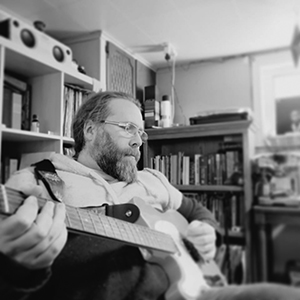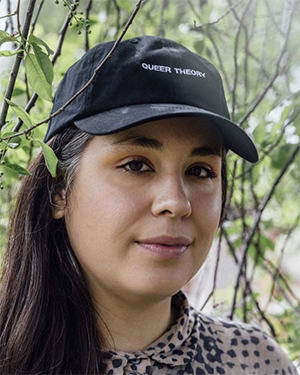Creation is Hybrid: Emily Riddle in Conversation with D. A. Lockhart

Past judge and contributor Emily Riddle talks with D. A. Lockhart, judge for our 2022 Constance Rooke Creative Nonfiction Prize contest. They discuss research as physical presence, the importance of the process, and writing about the urban Indigenous experience.
D. A. Lockhart is the author of nine books, including Bearmen Descend Upon Gimli (Frontenac House, 2021), Breaking Right (Porcupine’s Quill, 2021) and Go Down Odawa Way (Kegedonce, 2021). His work has appeared in Best Canadian Poetry in English 2019, TriQuarterly, ARC Poetry Magazine, Grain, Belt, and The Malahat Review among many. Lockhart is a graduate of Indiana University-Bloomington MFA in Creative Writing. He is a Turtle Clan member of Eelünaapéewi Lahkéewiit (Lenape), a registered member of the Moravian of the Thames First Nation, and currently resides at the south shore of Waawiiyaatanong (Windsor,ON-Detroit, MI) and Pelee Island.
As someone who grew up in an urban part of her traditional territory, I think a lot about the ceremonies and prayers embedded in the land of Edmonton and in other cities by our ancestors. Your projects often speak to the recent Indigenous history of cities and landscapes that are often forgotten in Canadian and American literature. Why is this an important part of your work?
The focus on the urban Indigenous experience is particularly critical for me and the region I call home. This is because there has been a very active and ongoing push by Windsor’s municipal government narrative that there weren’t Indigenous folks when settlers arrived at Waawiiyaatanong. And they often dispute the notion that any current First Nations folks were Indigenous to the region. They dug up burial mounds, dumped remains in the river, and have continually refused to use the traditional name for the region used by the Three Fires Confederacy for millennia. There is no mention of the ignition of the Second Fire of Medewin occurring within the current city limits, no recognition of the traditional Odawa-led villages in the area. I find that I have to push our more recent history and continued presence here because for the majority of my lifetime Indigenous folks have been solely discussed in the past tense. The only space left for us as Indigenous folks has been one constructed on fundamental racist stereotypes. Cities, like all of the lands of Turtle Island, are stolen Indigenous land. Regardless of all the attempts at forced relocation (see the Midwestern aspect of our history) and forced assimilations, us urban Indigenous folks have carried on. And have done so on the frontlines of the cultural exchange that is colonialism. And survival often leaves us with a complex set of relations and cultural adoptions. And the majority of Indigenous folks, like non-Indigenous folks, live in cities. Waawiiyaatanong has close to 30,000 treatied citizens of First Nations living within it. And we are as diverse looking and acting as the others living on our lands. Writing about Indigenous cities is an absolutely critical part of rekindling that 8th Fire of ours. We’ve changed a great deal over the last five centuries plus of colonization. And we need a written record of this change to challenge the vast amount of misinformation put into the world by the likes of pretendians and white supremacists. My work, my life has been about rekindling the culture of my Lenape ancestors. Telling our stories, like we do during our annual Gamwig ceremony, is so important. We are the only truly important touchstones, survivors if you will, in a world that is run by people that have repeatedly tried to maim or kill us. We give testimony of the world(s) we inhabit. A gentle reminder that we live and have walked through the world like our ancestors. Even though the world has fundamentally changed. We need to understand that we have survived and how we have done so is important. You can say that I write about this because it is the truth of being a Lenape in the 2020s. And that those sorts of truths, since the moment we fled our homelands centuries ago, has been the one thing that subsequent settler governments right up to today’s municipal governments like the Corporation of the City of Windsor have been trying to keep away from people of both Indigenous and non-Indigenous governments.
Your work, whether poetry or nonfiction, often contains a significant amount of research, which can mean different things for creatives and Indigenous peoples. I’m thinking in particular of Go Down Odawa Way and your journey in learning more about Waawiiyaatanong. Can you share a bit about your research methodology in your creative writing practice?
Research strategies definitely vary for me from project to project. And my training as an academic librarian maybe tends to push me towards an often colonial or conservative notion of research at times. I often start there, in the various research papers and nonfiction titles that can add to a knowledge base of what I’m looking to talk about. But as you know, that academic style of research is fundamentally flawed. The personal matters, regardless of what your comp instructor told you. Most of the best poets and writers that I’ve studied under definitely have illustrated this. We need to see a piece breathe as if full of life. This is the personal. And to learn the personal we need to touch the land to understand it. There is a clear experiential aspect to my writing research. This is the honest portion, the part that really differentiates the average piece of writing to the successful and good piece of writing. Al Purdy talked about this a lot in his letters to Charles Bukowski, this idea that the honesty and lyricism of successful work relies upon the experiences and physical presence of the writer. Academia often misses this. This is why my formal training has never been enough. One still does need lived experience to form the basis of what we are doing. But after getting one’s footing in material, a path to follow to write about, one needs more. There are questions of form and even an approach to hunting down images or points of view. This means I turn to the literary texts, the poetry collections, novels, short fictions, essays, that have approached similar topics and done so in a manner that engages me and leaves something positively embedded in my memory. Basically you could break down writing into factual research then personal voice research and lastly form and style based research.
Often the nonfiction I like best comes from people who are also poets. Wënchikàneit Visions is a collection of essays, but poetic, experimental ones invoking the conventions of a Lenape Big House Ceremony. I often think Indigenous writers are best positioned to write beyond genre, with our stories spilling out against the conventions of Canlit. How do you conceptualize your relationship to genre in relation to your nation’s history of storytelling?
Genre is often like every other box that the world likes to and attempts to squeeze things and people into. I get the need to have some talking points about a piece of work or otherness, but the simple fact is that nothing fits neatly in those boxes and categories. Because the categorization is fundamentally tied to colonial notions of identity. And this is important, this sort of categorization is really what has been holding so much of us First Nations. We fight over status cards, sacredness, being a “sell-out,” who owns what. All of which might have kernels of truth buried within them, important truths at that. But the categorization is the issue. It sets up dichotomies, oppositions, which journalists and social media love. If writing and storytelling are the ways we dream of ourselves, but what we do in terms of talking about and creating work collapses into these dichotomies and hard categories, then we are fulfilling nightmares rather than dreams. Creation is fundamentally hybrid. As are our stories and reflections of it. There is no mythology. There is no horror. There is no science fiction. There is only writing and words and reflections of creation as we place them into stories and moments. Categorization and strict lines of genre amount to ways to discredit, or at worst silence, dissenting voices from the dominant discourse.
I love hearing about the reading practices of writers because I think one is so important to the other. Are there books you always come back to for inspiration? Do you find yourself more drawn to one genre when you are writing another?
There are books I return to time and again. And I do often find myself reading across genres when it comes to finding new paths for projects. Go Down Odawa Way was heavily influenced by essays on Detroit and urban Indigenous folks in Chicago. But there is a cluster of works I return to frequently regardless of which genre I am working on. For guidance. For joy. James Welsh’s poetry is frequently on my list. His Earthboy at 40 collection I hold close to my desk. I often use the small poems in the collection to launch my work for the day. And to that extent Jim Harrison’s Complete Poems is nearby as is Richard Hugo’s The Lady in the Kicking Horse Reservoir. My Montana ties are definitely showing. But these are writers that are as concerned about the physical world around them, and its histories, as much as they are about their internal struggles. So, they could speak to Waawiiyaatanong as much as such the Gallatin Valley. As a Hoosier fiction writer, I would be remiss to not include Kurt Vonnegut’s work, specifically God Bless You, Mr. Rosewater. Clever, observational humour/satire, mixed with a little science fiction is the stuff of Lenape dreams. Bonnie Jo Campbell’s American Salvage, its grittiness and honesty has been a real draw to me. And this is an interview about nonfiction so I would be remiss not to talk about Ted Kooser’s Local Wonders: Seasons in the Bohemian Alps or Scott Russel Sanders’ Writing from the Centre. These are two books that personify the rooted land-based writing in the contemporary sense that I so adore. They speak to the places that I long for and the portions of creation I draw so much of my energy from.
What will immediately grab your attention in a creative nonfiction contest entry? What causes you to immediately lose interest?
Coming from the poetic tradition, the easiest answer to that is a piece that sings its way into being is most likely to grab my attention. What this means in practice is I am looking for pieces that want to tell me something and tell me something beautifully. My mind operates in the world of things, meaning that leaning on images and concrete experiential lyricism will definitely find a receptive reader in me. I want to get them and their experience. Basically, tell me something, do it beautifully or in a manner that I connect with. Make it personal and honest. Avoid being didactic, to an extent. Sure, your point could be a critical one to make, but ease me there to that point like a Charles Mingus jam. The point is important, but so is the process or the journey.

Emily Riddle
* * * * * * * *









